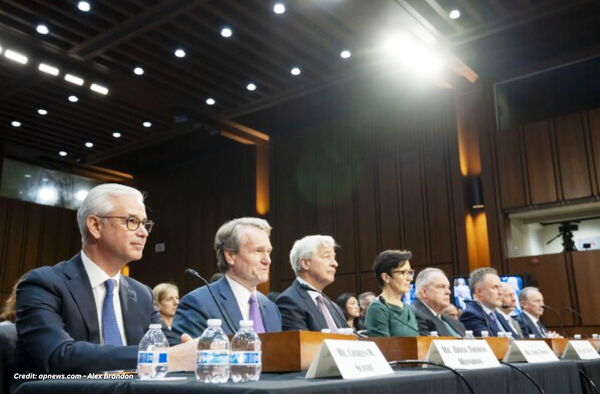Senate hearing dominates Big Four bank
Share

The Big Four bank CEOs would have been extremely unhappy on Friday as they monitored the Canberra hearing of the Senate enquiry into bank closures in regional Australia.
What they heard in that hearing is literally their worst nightmare: strong advocacy for a government-owned bank, operating through post offices, to force the Big Four to truly compete.
Australia had public banks for more than a century before they were all privatised in the 1980s and 1990s, under lobbying pressure from the private banks whining that having to compete with public banks was unfair.
Talk of re-establishing a public bank terrifies the Big Four banks more than anything else.
Following a year of the Senate enquiry hearing stories of appalling private bank behaviour, the enquiry heard from multiple witnesses promoting a public bank solution, including the Licenced Post Office Group (LPOG), public policy think tank Per Capita, and the Australian Citizens Party (ACP).
LPOG Chair Scott Etherington and Executive Director Angela Cramp testified on the role of post offices in banking services. When asked by inquiry Chair Senator Matt Canavan if the LPOG supported a government postal bank, Scott Etherington replied:
“We’d be absolutely supportive of a government bank and using the Australia Post network as its agency to provide the face-to-face services. We think that would be an excellent solution.”
Emma Dawson testified on Per Capita’s 2020 report, “PostBank: Filling a Void, Securing Essential Services,” which recounts the story of the establishment of Kiwibank in New Zealand in 2002.
“Just as we would not leave the creation and maintenance of our health system or our roads entirely in private hands, we should not leave our banking services, financial infrastructure, and financial stability entirely in private hands,” Emma Dawson said. “A government-owned bank offers many benefits to Australians, including improving services to those currently underbanked customers, especially in rural and regional areas, improving standards across the financial services industry, and providing stability to Australia’s economy in times of volatility in international financial markets.”
After years of helping to establish many Senate enquiries into banking-related issues, including this one, in a historic first, the ACP was finally invited to testify on “Why a national People’s Bank is the solution to the crisis of bank branch closures.”.
Addressing the ACP’s witnesses, Research Director Robert Barwick and Executive Member Glen Isherwood, enquiry Chair Matt Canavan opened: “I do want to also thank and recognise both of your
efforts in both following the enquiry, at cost to yourselves, all around the country, and also just your involvement generally—it’s been very, very useful. We appreciate your interest.”
Robert Barwick said: “We know a public post office, People’s Bank, will stop the Big Four banks in Australia from closing branches because it’s happened before. In 2002, when Kiwibank started [in New Zealand], their banks, which are owned by our Big Four banks, stopped closing branches for seven years straight. They had closed 1,300 branches in the two decades before that; there were no branch closures in New Zealand for seven years straight after Kiwibank was established. That’s why we support this solution to this enquiry.”
Glen Isherwood pointed out that one man in New Zealand, Jim Anderton, championed Kiwibank, just as King O’Malley had championed Australia’s Commonwealth Bank, which had eventually overcome the powerful opposition of the private banks: “You do need a Jim Anderton, you do need a King O’Malley in this place to not take ‘no’ for an answer, to take that determination forward”, Isherwood said.
The ACP urged the committee to recommend the public solution in its report, due in May 2024.

Justin Lavadia is a content producer and editor at Public Spectrum with a diverse writing background spanning various niches and formats. With a wealth of experience, he brings clarity and concise communication to digital content. His expertise lies in crafting engaging content and delivering impactful narratives that resonate with readers.


Today’s Pick
11th Annual Aus Goverment Data Summit
April 1, 2025
7th Annual NZ Government Data Summit
May 7, 2025
3rd Public Sector Comms Week
May 14, 2025
Subscribe
We send emails,
but we do not spam
Join our mailing list to be on the front lines of healthcare , get exclusive content, and promos.
AI appointment Australia Australian boost boosts business businesses covid-19 cyber cyber attack cyber security cybersecurity data data breach data management defence Digital employment enhance enhances fraud funding governance government grants infrastructure Innovation Lockdown management new zealand NSW NZ online privacy public Public Sector queensland renewable energy scams security Social Media Technology telecommunications victoria
-

Understanding and building your digital strategy
Digital Government, Opinion
-

Featured Leader: Jamie Morse on multi-channel strategies for communication
Communications, Featured Leader
-

Featured Leader: Tegan Tembe of NSW Treasury on creating solid planning strategies and processes
Featured Leader
-

Wirraka Maya Health Service improves patient care with My Health Record
Learning
Show More-

Effects of ineffective communication in the workplace
Communications, Personal Development
-

7 ways you can enhance your personal development skills
News, Personal Development
-

5 advantages of working in the public sector
News, Personal Development, Professional Development
-

7 causes of communication issues in the workplace
Communications, News, Personal Development
Show MoreLast Viewed